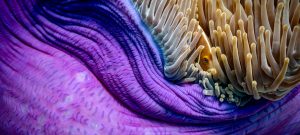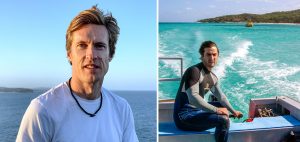By Martin Enserink
When Philip Munday discussed his research on ocean acidification with more than 70 colleagues and students in a December 2020 Zoom meeting, he wasn’t just giving a confident overview of a decade’s worth of science. Munday, a marine ecologist at James Cook University (JCU), Townsville, was speaking to defend his scientific legacy.
Munday has co-authored more than 250 papers and drawn scores of aspiring scientists to Townsville, a mecca of marine biology on Australia’s northeastern coast. He is best known for pioneering work on the effects of the oceans’ changing chemistry on fish, part of it carried out with Danielle Dixson, a U.S. biologist who obtained her Ph.D. under Munday’s supervision in 2012 and has since become a successful lab head at the University of Delaware (UD), Lewes.
In 2009, Munday and Dixson began to publish evidence that ocean acidification—a knock-on effect of the rising carbon dioxide (CO2) level in Earth’s atmosphere—has a range of striking effects on fish behavior, such as making them bolder and steering them toward chemicals produced by their predators. As one journalist covering the research put it, “Ocean acidification can mess with a fish’s mind.” The findings, included in a 2014 report from the Intergovernmental Panel on Climate Change (IPCC), could ultimately have “profound consequences for marine diversity” and fisheries, Munday and Dixson warned.
But their work has come under attack. In January 2020, a group of seven young scientists, led by fish physiologist Timothy Clark of Deakin University in Geelong, Australia, published a Nature paper reporting that in a massive, 3-year study, they didn’t see these dramatic effects of acidification on fish behavior at all.
The paper has proved so polarizing in the field, “It’s like Republicans and Democrats,” says co-author Dominique Roche of Carleton University in Ottawa, Canada. Some scientists hailed it as a stellar example of research replication that cast doubt on extraordinary claims that should have received closer scrutiny from the start. “It is by far the best environmental science paper I have read for a long time,” declared ecotoxicologist John Sumpter of Brunel University London.
Others have criticized the paper as needlessly aggressive. Although Clark and his colleagues didn’t use science’s F-word, fabrication, they did say “methodological or analytical weaknesses” might have led to irreproducible results. And many in the research community knew the seven authors take a strong interest in sloppy science and fraud—they had blown the whistle on a 2016 Science paper by another former Ph.D. student of Munday’s that was subsequently deemed fraudulent and retracted—and felt the Nature paper hinted at malfeasance. The seven were an “odd little bro-pocket” whose “whole point is to harm other scientists,” marine ecologist John Bruno of the University of North Carolina, Chapel Hill—who hasn’t collaborated with Dixson and Munday—tweeted in October 2020. “The cruelty is the driving force of the work.”
What few researchers know is that in August 2020, Clark and three others in the group took another, far bigger step: They asked three funders that together spent millions on Dixson’s and Munday’s work—the Australian Research Council (ARC), the U.S. National Science Foundation (NSF), and the U.S. National Institutes of Health (NIH)—to investigate possible fraud in 22 papers.
The request, which they shared with a Science reporter, rests on what they say is evidence of manipulation in publicly available raw data files for two papers, one published in Science, the other in Nature Climate Change, combined with remarkably large and “statistically impossible” effects from CO2 reported in many of the other papers. They also provided testimony from former members of the Dixson and Munday labs, some of whom monitored Dixson’s activities and concluded she made up data.
ARC and NSF declined to discuss the case with Science, but said they generally refer such cases to the research institutions—in this case JCU; the Georgia Institute of Technology, where Dixson worked between 2011 and 2015; and UD. NIH said it refers cases to the U.S. Office of Research Integrity, which does not comment on cases.
Munday calls the allegations of fraud “abhorrent” and “slanderous,” and a JCU spokesperson says the university has dismissed the allegations after a preliminary investigation. (Munday retired from JCU in April and has moved to Tasmania, but emphasizes there is no connection between that timing and the allegations.) UD says it cannot comment on personnel matters; a Georgia Tech spokesperson declined to comment except to say the institute “takes all allegations of research misconduct seriously.” Dixson denies making up data as well. “I fully stand by all the data I’ve collected, I stand by the papers that we’ve published,” she told Science in a February interview. “The data was collected with integrity. I mean, I preach that to my students.”
But multiple scientists and data experts unconnected to the Clark group who reviewed the case at Science’s request flagged a host of problems in the two data sets, and one of them found what he says are serious irregularities in the data for additional papers co-authored by Munday.
The fight, between two groups united by their passion for fish, isn’t just about data and the future of the oceans. It highlights issues in the sociology, psychology, and politics of science, including pressure on researchers to publish in top-tier journals, the journals’ thirst for eye-catching and alarming findings, and the risks involved in whistleblowing.
Members of the Clark group say they will soon publicize the alleged data problems on PubPeer, a website for discussion of published work. And they say they thought long and hard about whether to discuss their concerns with a reporter while investigations may be ongoing. “In my experience, whistleblowers, myself as well as others, are shamed for talking to the media before an investigation has concluded misconduct,” says Josefin Sundin of the Swedish University of Agricultural Sciences, the last author on the Nature replication paper. “But why is that? If an investigation even takes place, it can drag on for a very long time. If you know that data have been fabricated, why is it considered the right thing to do to stay silent about it for months and even years?”
TOWNSVILLE MAY BE ONE OF THE WORLD’S best places to go if you want to become a marine biologist. JCU’s website boasts “a unique tropical learning environment with research stations, state-of-the-art laboratories and the Great Barrier Reef right on our doorstep.” The university is home to the ARC Centre of Excellence for Coral Reef Studies, where Munday had his lab. For field studies, scientists fly to Lizard Island, a granite rock on the reef that’s legendary among marine biologists, thanks to the Australian Museum’s well-run research station, otherworldly diving, and beach barbecues. (“Man, I miss that island,” Dixson tweeted last year.)
Munday’s lab has been one of the engines of JCU’s success. Originally focused on competition in reef fish and their ability to switch sex, Munday shifted his attention to ocean acidification in the late 2000s. Dixson, who arrived at JCU in 2007, embraced the topic.
Acidification, which results as rising CO2 levels cause more of the gas to dissolve in the ocean, poses serious threats to ocean life, weakening corals and other organisms with carbonate shells or skeletons. But a 2009 paper in the Proceedings of the National Academy of Sciences (PNAS) on which Munday and Dixson were the first and second author, respectively, reported another troubling effect. When the pH of the water in fish tanks was lowered from 8.15, the current level in ocean water, to 7.8, the level expected by the end of the 21st century, larvae of the orange clownfish were less attracted by the chemical cues from a healthy reef—but more attracted to cues from grass and a pungent swamp tree whose smell normally repels them. That could cause clownfish to lose their ability to find suitable homes on the reef, the authors concluded.
Based on more lab experiments, Munday, Dixson, and other researchers later reported that high CO2 levels mess with fish minds in other ways as well: They become disoriented, hyperactive, and venture farther from shelter, for instance, while their vision and hearing deteriorate. For many of those studies, the scientists measured fish’s preferences by placing them in a flume, an apparatus that forces them to make a choice (see graphic, below). Water from two different sources flows into the flume, side by side, and researchers measure how much time the fish spend in water from either source.
Source: https://www.sciencemag.org/









